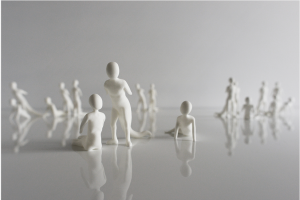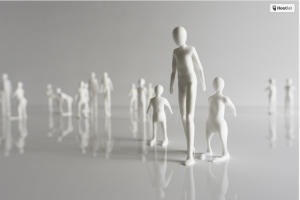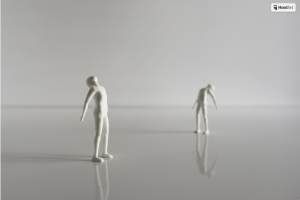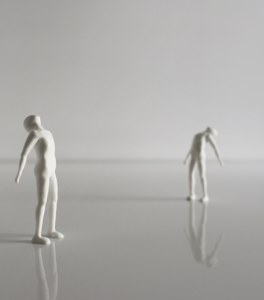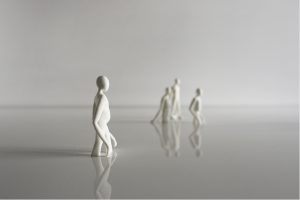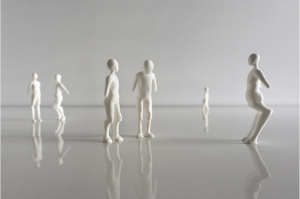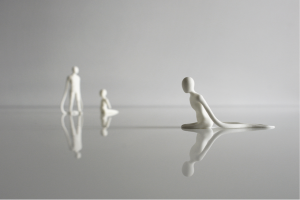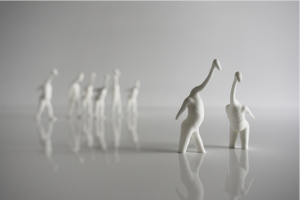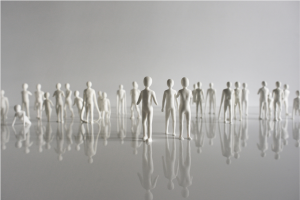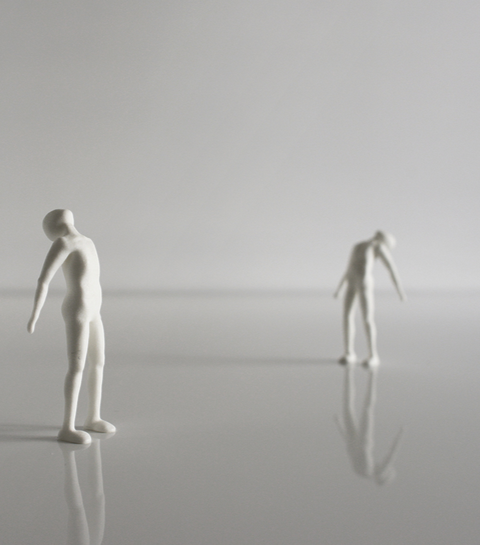 At first sight, the teeming white figures seem to represent the active citizenry of a metropolis, all out and on their way about their daily lives. However, get closer and you realize that these are no ordinary creatures. Each is nearly human and some are partly so. Some have limbs that grow like tentacles while others are missing parts of their arms or legs. Others are bent at unusual angles, have grown together, or seem to be in the process of sprouting from the earth. All are 3D printed in white and spring from the imagination of New York-based artist Marcy Milks.
At first sight, the teeming white figures seem to represent the active citizenry of a metropolis, all out and on their way about their daily lives. However, get closer and you realize that these are no ordinary creatures. Each is nearly human and some are partly so. Some have limbs that grow like tentacles while others are missing parts of their arms or legs. Others are bent at unusual angles, have grown together, or seem to be in the process of sprouting from the earth. All are 3D printed in white and spring from the imagination of New York-based artist Marcy Milks.
Whether walking with tails or on attenuated legs, the figures seem oddly uplifting. They are all going somewhere, somehow and no one is normal. In a sea of freaks, each is simply a being.
Called The Population, the all-white figures are placed on a white table in a white environment, a choice the artist explained in a video interview conducted at the installation, titled Segment 151, which displayed of 300 of her figures:
“For me, I like to think that this sort of absence of color is blank. It’s something where they are just starting their development; it’s just starting their evolution. And while it is blank and unprescribed, it also makes them very simple. It’s intentional, to hopefully allow the viewer to focus in on just the mutation, really that is the important part: looking at what is different in each one.”
The figures are sculpted in ZBrush, starting with the creation of a basic form from spheres. Each limb is pushed and pulled to cause its individual type of deformation. Additional details are then added to the 3D form using the program’s advanced sculpting tools. When the sculpting is complete, Milks poses the figures in space and the file is rendered to create the final image of the creature.
Bringing these individuals from digital to physical is made possible in such numbers by 3D printing them. To say nothing of the time required for the design of each figure, the making of 20,000 sculptures, even were they all to be the same, would be time consuming when performed in a non-industrial setting. The ability to utilize a 3D printer gives this single artist the possibility for creating this type of work in a greatly compressed time frame.
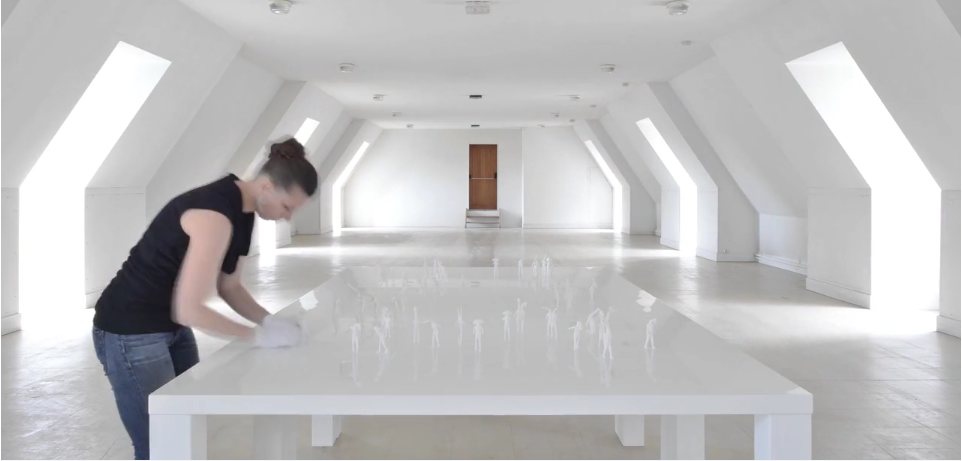 The figures have been organized into categories based on the type(s) of mutations present in their form. For example, the longus nasus figures have been joined together by facial protuberances although they still have individual poses and vary in their additional characteristics. The utilization of a latinate naming convention to categorize her creation emphasizes the connection she sees between the design inputs and their DNA. These figures may not move, but they are definitely dynamic and you get the very real impression that if you came back to see them later, they would have continued to define themselves.
The figures have been organized into categories based on the type(s) of mutations present in their form. For example, the longus nasus figures have been joined together by facial protuberances although they still have individual poses and vary in their additional characteristics. The utilization of a latinate naming convention to categorize her creation emphasizes the connection she sees between the design inputs and their DNA. These figures may not move, but they are definitely dynamic and you get the very real impression that if you came back to see them later, they would have continued to define themselves.
The idea that human beings are all one big family is predicated on the macro scale view that smooths over the differences among us as individuals. The scale of these figures–they range from 2″ to 6″ or so–means that as we view them in a video or from from a standing position at the foot of the table, they at first appear to be relatively homogeneous. We have to let our eyes adjust and really begin to look before we can see that they are, in fact, even more extremely different than was imagined. And yet, there is no difficulty realizing that they, together, constitute a population. This oscillation between generalization and specificity is one that each of us confronts every day. Members of a group are conceptualized as generically similar and yet any careful examination reveals that to be an absurd impossibility. We know this, and yet we continue to work in the abstract with categories, while the edge between these two lenses is rough and sometimes damaging.
 Milks asks us to imagine an evolution that would continue to exaggerate humanity’s differences and yet somehow these figures seem to sit more comfortably as part of a population. In their unmarked shells and blank environment, they somehow exist in a state before the development of hierarchy – or perhaps after its destruction. I wonder how the other figures might react should one among their member develop a color? Would this destroy the balance of the sameness that connects them all across such great differences?
Milks asks us to imagine an evolution that would continue to exaggerate humanity’s differences and yet somehow these figures seem to sit more comfortably as part of a population. In their unmarked shells and blank environment, they somehow exist in a state before the development of hierarchy – or perhaps after its destruction. I wonder how the other figures might react should one among their member develop a color? Would this destroy the balance of the sameness that connects them all across such great differences?
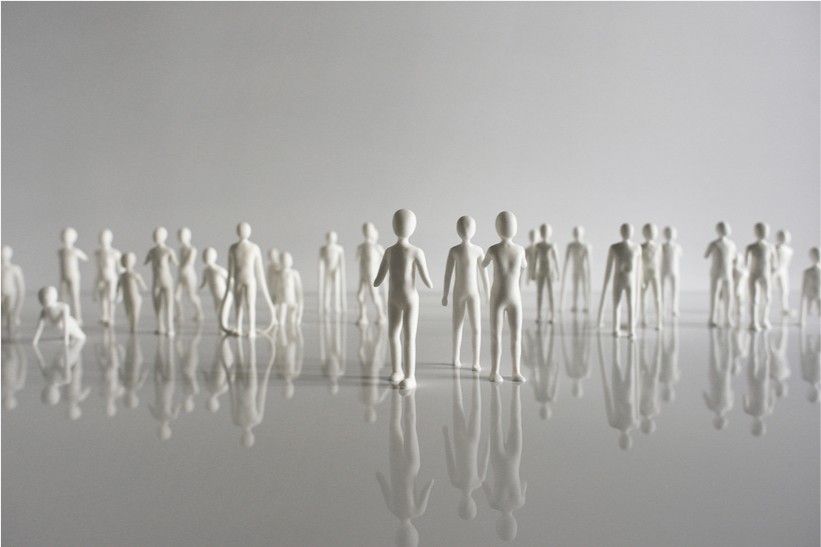 Somehow, Milks has managed to take a series of figures that Heironymous Bosch would have used to illustrate the deepest bowels of Hell and make them into the everyday folks that mill anonymously through public space.
Somehow, Milks has managed to take a series of figures that Heironymous Bosch would have used to illustrate the deepest bowels of Hell and make them into the everyday folks that mill anonymously through public space.
That is, in and of itself, pretty amazing.
Let us know your thoughts about this incredible conceptual piece in the 20,000 3D Printed Figures forum thread over at 3DPB.com. Check out more images from Milks’ art below.
Subscribe to Our Email Newsletter
Stay up-to-date on all the latest news from the 3D printing industry and receive information and offers from third party vendors.
You May Also Like
IperionX Inks 10-Year Deal with Wisconsin Manufacturer for 80 Metric Tons of Titanium Per Year
IperionX, the Charlotte-based supplier of sustainable titanium powders used for additive manufacturing (AM) and metal injection molding (MIM), has signed a ten-year deal with United Stars, a group of industrial...
Gastronology Launches Industrial Production of 3D Printed Food for Dysphagia Patients
Food 3D printing has, in many ways, been an additive manufacturing (AM) segment looking for the right business case. While some applications are beautiful and others may or may not...
Lockheed Martin Leads $3M Investment in Q5D’s Electronics 3D Printing System
Q5D, an original equipment manufacturer (OEM) of robotic arm, hybrid additive manufacturing (AM) systems used for wire harness production, has closed a $3 million investment round. The investment arm of...
3D Printing News Briefs, April 6, 2024: Depowdering, Cybertruck Door Handles, & More
In today’s 3D Printing News Briefs, ioTech’s digital manufacturing CLAD technology is opening up opportunities for microelectronics and additive manufacturing. Hexagon and Raytheon Technologies commercially released the Simufact Additive Process...


